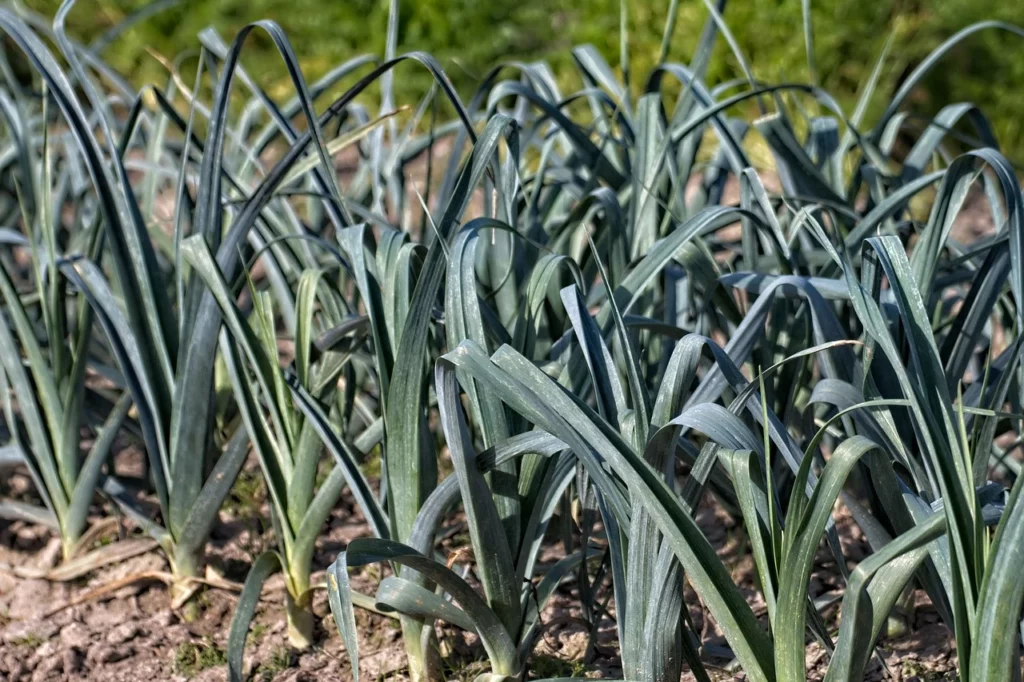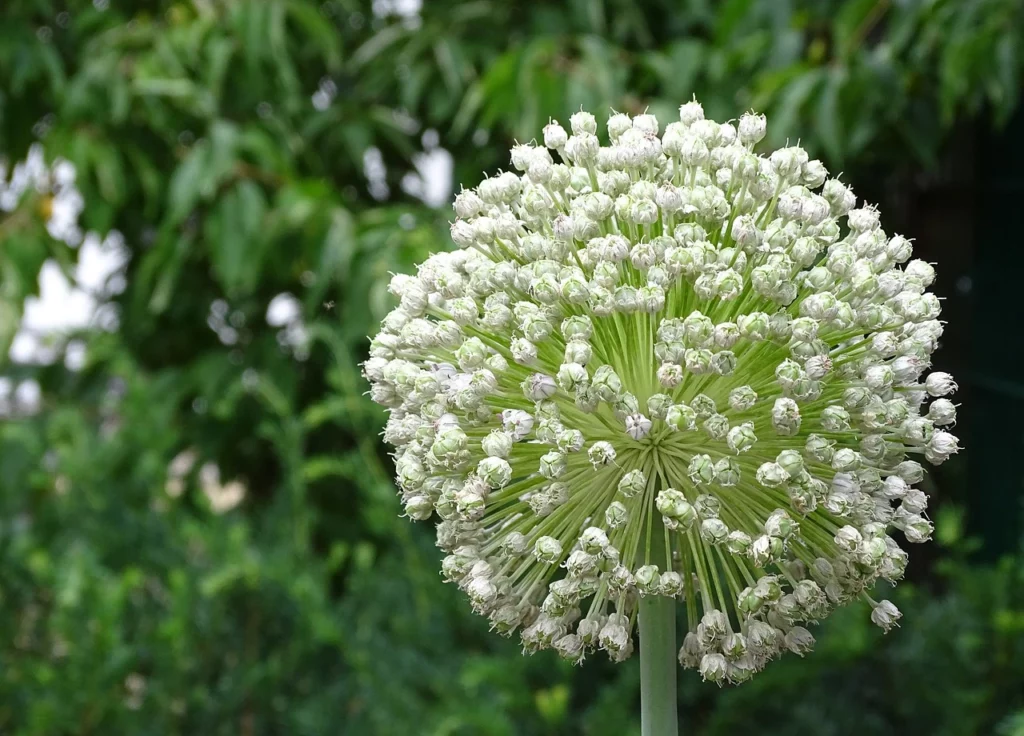Leek (Allium porrum), also called leek, like the onion, belongs to the Amaryllis family (Amaryllidaceae). The leek is actually a biennial plant. Through breeding, the emphasis has been placed on foliage growth, so that no bulb is formed at all. Today’s leek is a cultivated form of the field leek and originates from the Mediterranean region. It was already cultivated in Egypt and Mesopotamia around 2000 BC and probably only reached Central Europe in the Middle Ages. Here, leeks have been and still are highly valued and used medicinally because of their essential oils. Learn how to grow your own leeks in the garden here.
- At a glance
- Light: also copes well with shady beds
- Water: high water requirement, keep evenly moist
- Temperature: it is worth to grow in advance, because only if the temperature falls below 17 °C for a longer time, it can come to shooting!
- Nutrients: fertilize with compost and mature manure, additional watering with diluted nettle liquid manure promotes growth
- Soil: humus-rich and deep, avoid waterlogging!
- Planting distance: 30 cm
- Planting depth: 0.5 – 1 cm
- Harvest: after 5 – 8 months!
Contents
Summer leek, autumn leek or winter leek
Before you decide on a leek variety, you should first consider when you want to harvest your leeks. Depending on the sowing date, summer leeks are already ripe in mid-July. In principle, you can leave them in the bed all summer until you want to use them. This way you always have freshly harvested leeks at hand. However, you should harvest it before the first frost, because it is not winter-hardy. Autumn varieties can tolerate cooler temperatures and can be harvested from September onwards. Winter leeks can theoretically remain in the bed all winter and be harvested whenever you need them fresh. Here you can learn more about the topic: Growing vegetables in winter. By choosing the right varieties, you can harvest fresh leeks from your garden all year round. We have compiled some leek varieties for you here:
Varieties of summer leeks: ‘Hilari’, ‘Kulaures
Autumn leek varieties: ‘D’Elbeuf’, ‘Haldor’, ‘Herbstriesen’, ‘Sevino’.
Varieties of winter leek: ‘Blaugrüner Winter’, ‘Genita’, ‘De Carentan’, ‘Freezo’.
Location: location, soil and mixed culture
Leeks will grow almost anywhere, whether in a rather shady or sunny location. However, it does not like stagnant water at all, so rather sandy soils are advantageous. A layer of mulch, keeps the humus content of the soil high. You can find out what kind of soil you have in your garden by using a simple soil test and indicator plants. Early potatoes as a pre-crop loosen the soil thoroughly. In the case of leeks, a mixed culture with carrots is worthwhile. Both keep pests at bay.
Good neighbors: lettuce, cabbage, kohlrabi, parsnip, lamb’s lettuce, celery, arugula, carrots, tomatoes, strawberries, chamomile, oregano, salsify.
Bad neighbors: beet, pea, onion, bean, lovage, chives

Preculture or direct seeding: sowing leeks.
Direct seeding for leeks is almost not worth it, especially for inexperienced gardeners:inside. When young, the thin leek foliage is very fragile and immediately exposed to weather and predators when direct sowing. In addition, the soil must be very fine crumb and contain enough soft humus, so that the leeks can germinate intact. Therefore, we recommend to prefer the leeks in pots.
Sowing summer and autumn leeks: February – April.
Sowing winter leeks: April – May
Do not sow the leek seeds deeper than 0.5 – 1 cm. If the seeds are too deep, the leeks will not have enough strength to reach the surface. However, if the seeds lie too far on the surface, they will not germinate at all. Either you can sow wide cubes in the pots, but then you have to prick the leek plantlets later, or you put two seeds in each pot with a diameter of 4 cm. Be sure to water the pots or potting trays from the bottom so that the seeds are not washed deeper into the soil. You can also use a spray bottle to keep the top layer of soil moist. The growing pots should always be kept above 17 °C so that no shoots develop. This means the leeks will go into flower too quickly. After about six to nine weeks, the seedlings should be about pencil thick. Now is the time to plant out the leeks.
Outdoors: planting leeks
Leeks can be planted outdoors starting in April. Before you plant the leeks, the soil in the bed should be finely chopped and loosened. Leeks can be planted both in rows and individually in the bed. You can plant the leek seedlings in rows with a row distance of 20-30 cm and a distance within the rows of 15 cm. The best way to do this is to make a furrow in the ground and add some mature compost. If possible, sift the compost so that it also develops a fine structure. Then push the fine crumbly soil towards the leek seedlings so that they get a firm hold. As a single plant, you should leave a distance of about 30 cm around the leek to other plant neighbors. Tip: You can also plant leeks in your raised bed or mound bed, where the soil is usually nice and loose and rich in humus!
Fertilize and care for leeks properly
Since leeks are among the hungry heavy eaters, they should be provided with sufficient nutrients. Therefore, the bed can be prepared in the fall with compost and organic fertilizer. To do this, dig up the soil to a depth of 30 cm and add compost and fertilizer. Well-rotted cattle or pig manure is particularly suitable as organic fertilizer. In addition, green manuring with phacelia and lupine can have a supporting effect and loosen up the soil. Every four to six weeks you can fertilize the leeks with a little comfrey or nettle liquid manure. You can also mound the leek plants with soil up to just below the leaf axils. This will make the shoots nice and white and strong. In addition, mounding protects against frost. If you want to protect your leeks from pests, rain and hail, a protective net can help.
Harvesting leeks
Winter leeks from last season can still be harvested into May. Summer leeks are already ripe from mid-July. Therefore, leeks are in season almost all year round. For harvesting, it is best to use a digging fork to loosen the soil around the leeks. Then the leeks can be easily pulled out of the ground. The roots and upper parts of the plant can be put into your compost.
Tip: Summer leeks can even be harvested twice! However, for the first harvest you should not dig up the leek, but cut it off near the ground. Then mound the remaining stem a little and water it. After a few weeks, a second, narrower leek should have grown back. Perhaps you already know the principle from regrowing.
Diseases of leeks
Leek rust (Puccinia allii)
One of the most common diseases that appear in leeks is leek rust. Here, orange-colored pustules appear on the leaves, which contain the spores of the fungal disease. The good news: the rust fungus only affects leeks and cannot be spread to onions or chives. The bad news: if your leeks are affected, you should pull out all affected plants and dispose of them in the trash (not in the compost!). In addition, you should keep a close eye on the remaining leek plants for the next few weeks so you can weed them out early.
Leek moth (Acrolepiopsis assectella) and leek leaf miner (Napomyza gymnostoma).
Both pests eat small tunnels into the leeks. In the process, eggs are laid in the leek plants. In addition, light brown spots can be seen on the stems as a result of the feeding. Often the heart leaves of the plant die. Prevention is the answer here. Close-meshed crop protection nets prevent the flying insects from reaching the plants in the first place. These should be stretched over the leek plants throughout the spring and summer. In addition, a mixed culture with carrots, tomatoes, celery, dill or parsley effectively keeps both pests away. Leaves that are already infested should be cut off and discarded in the trash. If your leeks are already infested, treating them with neem oil can also help against the pests.
Yellow streak virus
You can recognize this virus, as the name suggests, by yellow stripes on the leaves. There is not much you can do about virus diseases, but you should dispose of infested plants in the trash in time.

Gain seed: Propagate leeks
If you want to gain seeds from your leeks, you’ll need to leave your plant(s) over the winter. Summer leek plants often don’t survive the winter, so it’s better to try winter varieties first. The biennial plant will then form an inflorescence the next year in summer. From this you can remove the black leek seeds with a rolling pin and let them dry. Leek seeds can only germinate for about two years. Since leek plants are always crossed with other plants to achieve genetic diversity, you will obviously need more than one plant. To obtain sufficient genetic variation, recommendations are that at least 20 different leek plants are needed. Don’t worry, this is not really possible in the home garden. Just know that you should not propagate with just a few plants over several years, as this can lead to inbreeding and associated diseases and susceptibilities. Since leeks are pollinated by insects, crossbreeding with other leek varieties or wild leeks can occur. Onions, cut leeks and garlic do not pose a cross-pollination hazard. So if you want to get a varietal leek, there should be no other leek varieties within a mile. Natural barriers such as walls or hedges reduce the radius to 400 meters.
Excursus: In professional seed growers, mosquito nets are stretched over the varieties. Boxes with pollinator insects are placed under the nets. In this way, the varieties are artificially separated from each other and seed collection is possible on one field.


